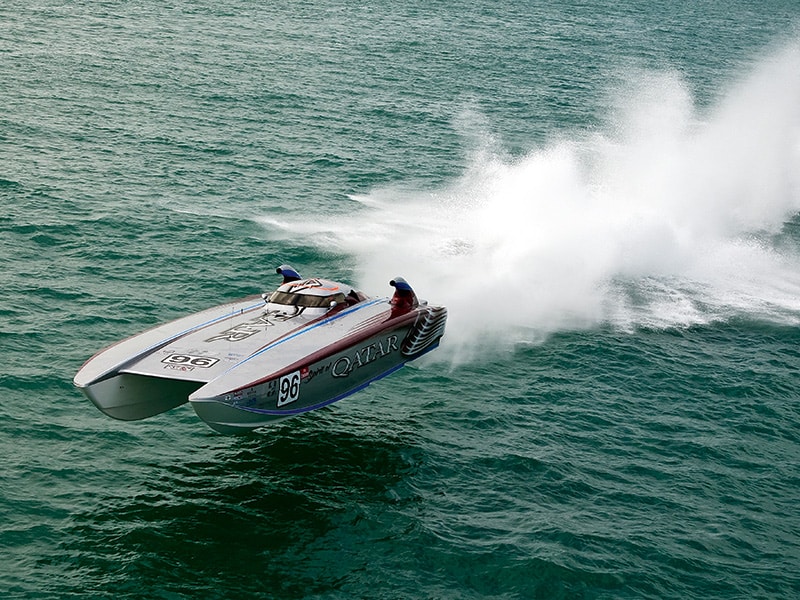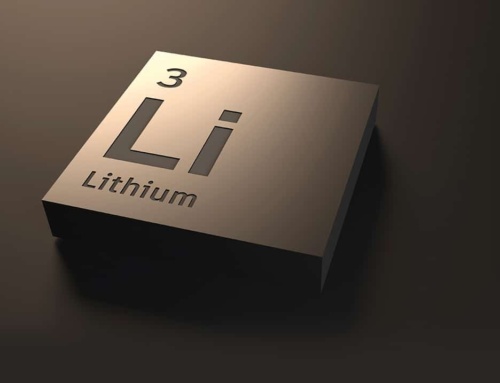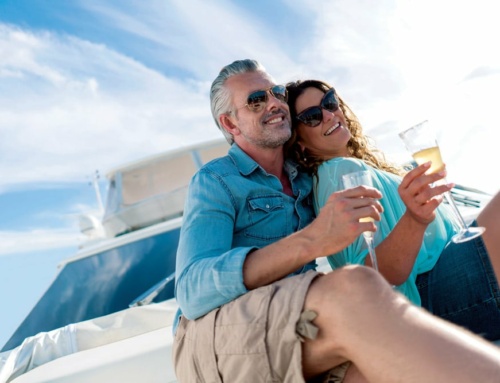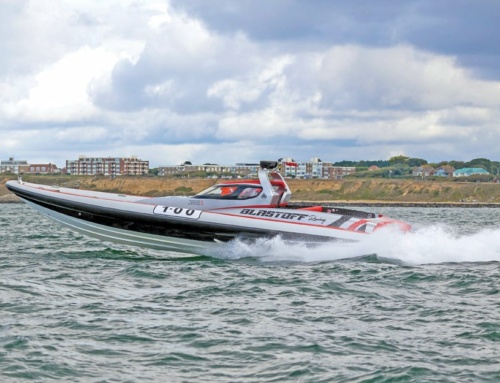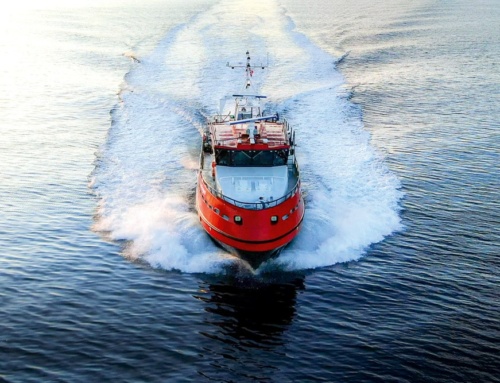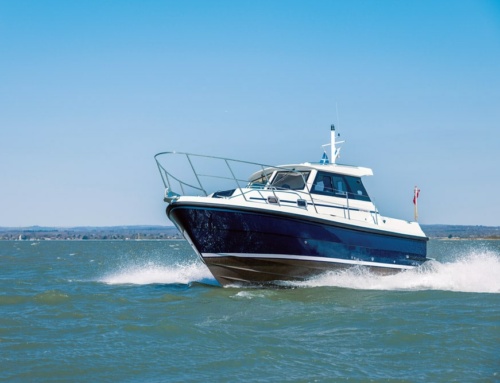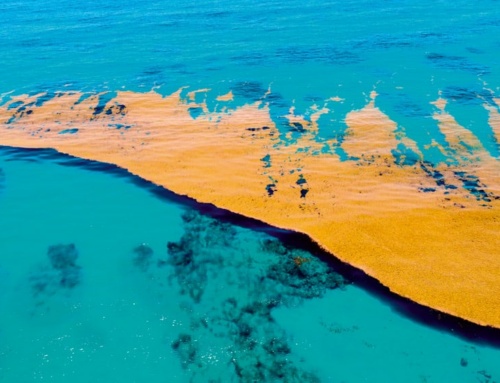- ‘All the while I love racing, and marathon events in particular, why would I stop?’
- … caution was the watchword of the day as Steve’s deft touch was essential to prevent the engines from over-revving because of the huge seas.
Mike Taylor catches up with multiple-award-winning powerboat supremo Steve Curtis to chat about his life and his win in the 2016 Cowes Classic.
In the 2016 Cowes–Torquay–Cowes powerboat race, throttleman Steve Curtis, with fellow crewmembers Richard Carr at the helm and Paul Sinclair doing the navigating honours, completed the event to a hero’s welcome. They were cheered on by a jubilant quayside crowd thrilled by the spectacle of their Cougar powerboat, Cougar US1 46,cutting through the waves after a hugely impressive race performance despite the worst ever seas in living memory.
Considered by many to be the best international powerboat racer of all time, Steve Curtis MBE has won the Class 1 Powerboat Championship an unprecedented eight times, becoming the youngest competitor to take this title. In 2003, he won the coveted Segrave Trophy, and he was awarded an MBE in the Queen’s 80th Birthday Honours List three years later.
‘I was absolutely thrilled about the Queen’s award,’ enthuses Steve looking back. ‘This very posh-sounding Scottish lady telephoned me and said: “Have you received our letter as you haven’t replied?” I thought it was the lads having a wind-up because I’d been away from home for several months and hadn’t seen my post. Then I realised it was for real. I went to Buckingham Palace and my parents were there; it was a brilliant day.’
Steve was born in Wimbledon, South London, in 1964. Encouraged by the upswing in interest in pleasure and powerboat racing, his father Clive started a yacht chandlery in London, and in 1968 he began racing a Sonny Levi-designed monohull hydroplane named Hummingbird with fellow powerboat friend James Beard. The pair then set up Cougar Marine and began designing and racing boats in the early 1980s. As a bet, Clive took part in the first Putney–Calais race, coming home ahead of the other craft in this prestigious event.
Steve was very close to his father, and enjoyed the sight of him winning various classes in numerous powerboat events. ‘His technique was always very smooth at the controls and I learnt a lot from him at a young age,’ Steve reveals. ‘He and I would talk endlessly about powerboat racing and boat handling.’
Asked to say more about his father, Steve says now that he was a very popular person, especially among the powerboat sport clique. ‘Many powerboat people, especially in the US, were hugely impressed by what he achieved. That said, for me it wasn’t easy to carve out my own career. At the beginning I was simply the son of someone very successful. When I won my first few races I was often referred to as “Clive’s boy”. But I didn’t mind; I was finding my own way in a tough demanding sport.
‘I think I inherited his competitive spirit, but it wasn’t a passion at the outset,’ Steve continues. ‘In fact, my early racing was on motorcycles. I was schoolboy junior motor cross champion on 100cc and 125cc bikes with Honda’s GB team. But the draw of the water finally took over and I went to the States where my father had already set up an operation. I was determined to race powerboats and I did everything I could to get behind the wheel, learning the hard way. I broke lots of boats in the process before winning my first Class 1 World Championship in 1985 at the age of 21.’
Initially, Cougar Marine focused on building racing boats. Significantly, the first catamaran ever to win an international offshore powerboat race came from the Cougar Marine yard and it was the first to win the tough world championship in Class 1. This signalled the start of Cougar craft dominance and paved the way for their links with Honda and the one-class race series and their participation in the Spirit of Qatar offshore racing team and even greater successes with Spirit of Norway.
In the late 1970s, Cougar Marine were incorporated within the Toleman Group and moved into the old Fairey Marine premises at Hamble Point. When Toleman ceased trading, Clive Curtis relocated operations to Warsash, situated on the opposite banks of the picturesque Hamble River, changing the name to Cougar Powerboats where he continued as CEO until his retirement when son Steve took over, sharing the responsibilities of business management with colleague Pete Currington.
As a youngster, Steve would often watch the C–T–C event with his father. ‘It’s a race that is universally associated with designers and organisers like the Levis and the Aitkens. It’s always been a big part of my life,’ he sighs. ‘I’ve taken part in three C–T–C events, one when I finished second to Fabio Buzzi in 1989 and on two other occasions when I didn’t finish.’
Come 2016, and despite his long and illustrious career, the C–T–C event remained the event Steve had yet to win (his father Clive achieving this victory in 1969). This year he was about to remedy the situation. ‘The Cowes–Torquay–Cowes race is the oldest event of its type, gaining considerable respect and a reputation in global powerboat circles for attracting the best powerboat people in the business,’ Steve asserts. ‘As a marathon event, it’s not just about the strength of the boat but rather it’s about the elements and what the weather can throw at you on the day as well. If it’s flat calm, then there’s no great effort involved, but when you get conditions as we had this year it is very different, and puts great strain on the boat and crew.’
Steve and fellow powerboat enthusiast Richard Carr have known each other for around 30 years and had always harboured a dream of entering this prestigious event together. The decision was finalised. Throttleman Richard would step aside to take the helm while Steve would manage the engine controls, with the job of navigator being given to Paul Sinclair.
As for a suitable boat, the choice was either to build a new one from scratch or use an existing craft known to the team. ‘We already had a suitable boat,’ continues Steve. ‘She is a 30-year-old monohull aluminium craft, initially designed by my father for Ben Kramer of Apache Powerboats, although she was never actually used by him in anger and was first raced by Tim Casulli as Maxon in the APBA Superboat class, later being modified from a triple- to a quad-engine installation. Then Maxon was lost from sight until she was bought for pleasure use. Later, she was rescued by Richard Carr with the notion of using her for racing. Renamed Cougar US1 46,she was converted back to triple engines to enter in the tough Venture Cup
“London–Monaco” powerboat race in 2013. Sadly, the race was cancelled.’
Plans were then formulated for the boat to take part in the Venture Cup event in early 2016. The Cougar Powerboats team went through the entire craft thoroughly. ‘The aluminium construction makes for a tough boat capable of handling the huge pounding that can occur in this event. In preparation, she was completely stripped back to bare metal with new wiring, controls and cockpit trim fit-out.’
Coincidentally, Mercury Racing had only recently launched a new range of race engines – the impressive 1350, 1550 and 1650 units based on a common cylinder block platform. Two 1350s with factory modifications were chosen as providing the most reliable horsepower delivery for the job driving through Mercury Racing’s M8 outdrive. It was to prove a wise choice. ‘We already had a deal with Mercury and the programme to race the boat in 2016 fitted our race calendar perfectly,’ acknowledges Steve. ‘Another advantage of the Mercury power train solution was that Mercury Racing operates a one-stop-shop service and advisory facility for race teams like Cougar.’
As for the hull form, Cougar US1 46 uses a conventional deep-vee profile, her construction providing a durable boat for events like the Venture Cup and Cowes–Torquay–Cowes where out-and-out speed is not essential. Sadly, the Venture Cup race fixture was cancelled for a second time, leaving a clear calendar window in which to prepare the boat for Cowes.
‘Despite the age of the boat we were confident in her ability,’ asserts Steve firmly. ‘In fact, initially I wanted to build a new boat from carbon fibre and Kevlar, which would have been lighter and faster. The reason that we didn’t was largely bound up with the fact that I was very conscious that by using an older boat like Cougar US1 46 it fitted the framework and image of the C–T–C event, the ethos that has made it the world-famous race it is today. We were almost going back to the old pleasure sports boat-type craft that were raced in the 1960s and 70s. In fact, I’d love to see other similar classic powerboats taking part in the future such as cigarette-type craft. The other benefit of using Cougar US1 46 was that the overall preparation and fit-out costs came to less than half a million pounds, markedly less than the bill for a new boat.’
When it came to shakedown trials, Steve says he was agreeably surprised at how well Cougar US1 46 handled. ‘We undertook a development programme managed in specific steps starting in Florida, the US base of Cougar Powerboats’ operations. There were no changes made to the bow and transom angles, though we did do some work on adding a pad to the keel. These are relatively flat sections designed to help smooth out the pounding through heavy waves, something that proved essential in the conditions we experienced in the C–T–C race.’
Then Cougar US1 46 was brought over to Cougar Marine’s UK HQ where the final stages in the programme were completed. ‘We ordered some new propellers followed by three days of sea trials to ensure we were totally happy with her performance. And though we knew we had a slight top-speed deficit compared to some other competitors, we felt that the robust construction linked to her handling in adverse conditions and the reliability of the Mercury engines gave us an edge.’
Preparations for the C–T–C race began on Saturday 3rd September when the boats congregated in the wet pits area of Vectis Marina in Cowes where the crowds could watch as the final fettling was carried out and the all-important testing finalised before the race.
The following morning dawned bright, if very windy, as the teams made their final adjustments and attended the mandatory race briefing. Fourteen powerboats then slipped their moorings at around 08:45 to proceed out into Southampton Water off Egypt Point by Gurnard North Cardinal Buoy in readiness for the 190-mile dash to Torquay and back. Forecasts of force 7 westerlies producing decidedly lumpy 13–19ft waves were predicted. It would be a bumpy ride.
At 09:30 the race began. Throttles were pushed to their limits and rooster tails sprouted all around. Along the water’s edge by Gurnard and toward Yarmouth, and off Fort Victoria and Hurst Castle, the crowds watched and waved at the powerboats as they tore past with an ear-shattering roar. The record speed for the course was set last year by Peter Dredge, Simon Powell, Malcolm Crease and David Gandy driving Vector Martini Rosso at a heart-stopping average speed of 94.55mph, and it was unlikely that this year’s teams would get anywhere near this lofty performance.
‘From the weather reports we knew the seas were going to be rough and that we had a boat that could stand up to these conditions,’ says Steve candidly. ‘One thing I didn’t want was to be in the wake of another boat as we made our way from Cowes. Another consideration was fuel burn. It’s a long race and we did make some quick off-the-cuff navigational changes mid race.’
From the off, conditions were filthy, and they would only get worse. Team Cougar passed Hurst Castle at 100mph and pushed on hard into Poole Bay where the waves forced them to make changes to their navigation plans, making them hug the coast off Milford and Christchurch, while dropping back to around 100mph, with the wind taking up station on their port quarter.
Clearly, caution was the watchword of the day as Steve’s deft touch was essential to prevent the engines from over-revving because of the huge seas. Approaching Durston Head by Old Harry Rocks, conditions did not let up, and by the time Team Cougar and the other craft had reached Portland and entered Lyme Bay, none of the crews reckoned they had witnessed the water so rough and Steve edged the throttles back again to 40–50mph. It took all of her 46ft and 2 tons of fuel to keep Team Cougar stable, skipping from one heart-stopping wave crest to the next, the sleek white craft often completely airborne and reaching some 6ft above the raging seas. Says Steve laconically: ‘The 10–15ft waves could not be ignored, so we decided not to run flat out with the possibility of sinking the boat, but rather to ease back.’
Among the front runners was Vector Martini Rosso (crewed by Peter Dredge, Simon Powell, Malcolm Crease and Jason McVicar) until technical problems at Portland resulted in them falling back, while Silverline (with Drew Langdon and Giancarlo Cangiano aboard) also slowed its pace with transmission failure. Things then got worse still when Langdon and Cangiano’s stricken boat was swamped by a huge wave. Next to take a hit was Outerlimits, which was partially sunk, with only its bow buoyancy aid keeping it afloat. A line was attached to the UIM Marathon Class A boat who rescued the crew, but the boat had to be left and recovered the following day.
Others who succumbed included the Italian entrant Tommy Racing (crewed by Maurizio Schepici and Gabriele Giambattista) and Hendricks 55 (with Miles Jennings, and Markus and Vincent Hendricks in command). This left the passage clear for Steve and his deft touch at the controls to bring Team Cougar to round the Torquay marker with an overall time of 4 hours 12 minutes at an average speed of 51.88mph, well ahead of Blastoff Racing (with Dorian Griffith, Shelley Jory-Leigh and Will Stevens aboard) who passed the buoy in second place with an average speed of 41.41mph, a full 47 minutes behind. Another incredible performance was put up by Thunderstreak (crewed by Robin Ward and Jeff Hall). The 53-year-old boat finished fourth, but sadly didn’t complete the course within the allocated time, crossing the line 51 minutes behind schedule. With such unforgiving conditions, only four boats arrived at Torquay and just three made it within the allotted time, ready for the return to Cowes.
Conditions on the dash back to Cowes were no less demanding. Even with the wind behind them, Steve, Richard and Paul elected to drop their speed still further. Nevertheless, the rough water took its toll, damaging one of the mountings for the hydraulic trim tabs. Then, within a short distance, Biretta Due experienced oil pressure loss, which left just Team Cougar and Blastoff Racing with any hope of completing on time and the chance of winning the coveted Beaverbrook Trophy.
Across the line at Cowes it was Team Cougar, averaging 51.88mph, with Blastoff Racing second, 1 hour and 21 minutes behind. Significantly, teammate Shelley Jory-Leigh aboard Blastoff became the highest-placed British lady competitor in the history of the race; only US racer Betty Cook achieved one better. Overall it was an incredible day for both competitors and spectators, and surely one to add to the history books for this notorious 55-year powerboat race.
‘Crossing the line in Cowes I think both Richard and Paul were almost overcome with emotion, having won this prestigious event,’ says Steve sagely. ‘It was nice to see the effect our performance had on them both and it was a great pleasure for me to race with them. Obviously I was pleased as well, but I also had my racing head on and was thinking “winning is what I do”.’
With hindsight Steve reveals: ‘I’ve sacrificed a lot in my life for powerboat racing. It’s nothing for me to race boats that are worth about one million pounds. There’s a complete high if we win, but total depression if we don’t. People think we’re jetting off around the world having a good time. But it’s not like that. There are birthday parties you miss, friends getting married that you can’t get to. It’s a very selfish sport. Probably 25 weekends a year I’m racing and then another five to eight I’m testing, so it ends up a pretty short year in the UK. But to be successful, you have to be totally dedicated.’
As for Cougar Powerboats today, things are buzzing at their Swanwick yard. Steve and Pete continue with the theme orchestrated by Clive Curtis, designing and building global-quality craft tested and proven on the world’s race boat circuits as well as building bespoke boats for clients. ‘I must never forget the business pull-through possibilities from racing, especially competing and winning in poor conditions like we had this year in the C–T–C. That the Cougar Powerboats brand stood up to these conditions gives confidence in government organisations around the world over ordering service craft like patrol boats. It’s the essential spin-off from successful powerboat racing.’
Looking to the future, people often ask Steve when he’s going to retire. ‘All the while I love racing, and marathon events in particular, why would I stop?’ he concludes thoughtfully. Meanwhile, Team Cougar are making plans for next year’s schedule of races, record runs, and of course another entry in the Cowes–Torquay–Cowes.
Achievements
- Steve Curtis’s achievements include:
- World Championship – 1985, 1987, 1997, 1998, 2002, 2003, 2004, 2005
- European Championship – 1998, 2002, 2003
- Middle East Championship – 2003, 2004
- Pole Position Championship – 2001, 2002, 2003, 2004
- World Speed Record in Spirit of Qatar in 2014: 244mph
Boat details
- Hull: Cougar
- Length: 46ft
- Engines: 2 x Mercury
- Total horsepower: 2700
Our thanks go to Steve Curtis MBE, Pete Currington and Richard Carr for their help with this feature.

